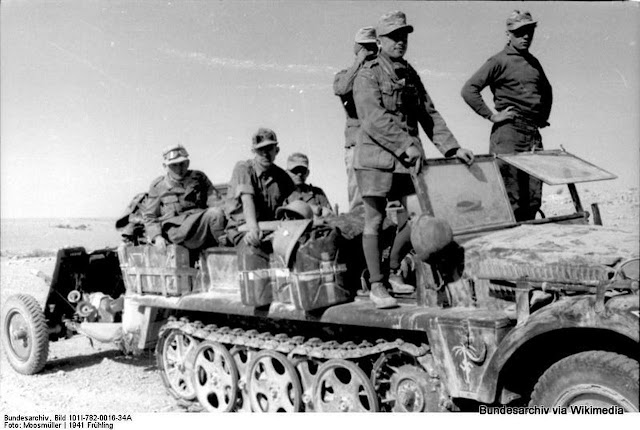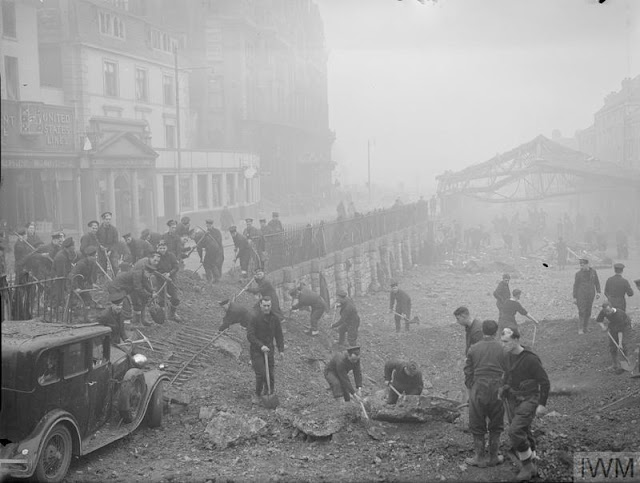Friday 21 March 1941
 |
| Plymouth, 21 March 1941. Original caption: "Long-distance view taken when St Andrew's Church (in the background) caught fire. The fire can be seen lighting up the church." Naturally, this is night-time and there is a total blackout, so everything would be black but for the fires. Plymouth Libraries, Local Studies Library. |
Mussolini essentially gives up on the stuttering Primavera Offensive. Even as his troops continue to attack, Mussolini leaves Tirana and flies back to Rome. The Italians continue battering against the Greek troops, supported by preceding artillery barrages, without success.
 |
| A picture of four crews from RAF No. 300 Squadron, based at RAF Swinderby, 21 March 1941. These crews were known as the first to bomb Berlin. No. 300 Polish Squadron Photo Gallery. |
At Keren, Middle East Commander General Archibald Wavell makes a rare appearance to observe the proceedings. He sees the 3 Royal Garhwal Rifles move into Happy Valley. The move is purely defensive and diversionary, with the troops put there simply to protect other units and create the impression in the watching Italians that they are about to attack the Acqua Gap.
 |
| "Bluejackets filling in a crater made by a large bomb." Plymouth, 21 March 1941. © IWM (A 3550). |
At dinner we are warned that the Hun arrives two nights running. Sure enough, just as the port arrives we are hurried into the cellars.... A frightful bombing breaks out.He notes that the "all clear" sounds after midnight. Menzies then vividly records a trip downtown to view the damage:
A frightful scene. Street after street afire; furniture litters the footpaths; poor old people shocked & dazed are led along to shelter. The Guild Hall is a beacon of fire. Buildings blaze and throw out sparks like a bush fire. There are few fire appliances and firemen.... Every now and then a delayed action bomb explodes (two were so close as to make me duck) or a building collapses.... I am all for peace when it comes, but it will be a tragedy for humanity if it comes before those beasts have had their own cities ravaged.At Clydeside in Scotland, the inhabitants are digging themselves out from the raids of a week ago - literally. Two men buried in a tenement basement finally are rescued.
RAF Bomber Command, meanwhile, sends 66 bombers against the U-boat pens at Lorient. The RAF also attacks German shipping off the Heligoland Bight and in the Heligoland Bight.
 |
| "Bluejackets filling in a crater made by a large bomb. Plymouth, 21 March 1941." © IWM (A 3551). |
The Ark Royal loses an aircraft of RAF No. 818 Squadron when it crashes on takeoff, with the crew killed. It is even worse than that: the plane is carrying a depth charge which explodes under the Ark Royal, damaging it.
Prime Minister Winston Churchill, a former First Lord of the Admiralty, continues to meddle in the Royal Navy's priorities. He memos the First Sea Lord that "No effort to destroy the Focke-Wulfs [Fw 200 Condors] should be spared." He even suggests placing a radar station on Rockall, an uninhabited rocky outcropping in the Northwest Approaches.
During the Luftwaffe raid on Plymouth, the Germans hit 303-ton minesweeping trawler HMT Asama. The captain beaches the Asama, but it is a total loss.
The Luftwaffe attacks shipping in the Bristol Channel. It sinks:
- 1260-ton British freighter London II in the Bristol Channel. The crew quickly abandons the blazing ship. There are four deaths
- 617-ton British freighter Millisle. There are ten deaths.
U-105 torpedoes and sinks:
- 5920-ton British freighter Benwyvis (34 deaths)
- 5802-ton British freighter Clan Ogilvy (61 deaths)
- 4038-ton British freighter Jhelum (8 deaths, the rest make it to Senegal and are interned).
British 2365-ton freighter Halo hits a mine off Beckton Pier in the Thames. The ship sinks but is later refloated and used for storage. There are four deaths.
Armed merchant cruiser HMS Derbyshire departs from the Clyde carrying troops bound for Reykjavik, Iceland.
Convoy HX 116 departs from Halifax.
Royal Navy corvette HMS Dahlia (Lt. Commander Magnus S. Work) and minesweeping trawler HMS Fluellen (Lt. Denys P. Richardson) are commissioned.
U-562 is commissioned, U-205, U-569, and U-570 are launched, and U-258 is laid down.
 |
| "The Norwegian sailors who helped in the clearing up of "blitzed" Plymouth, receiving well-deserved refreshment." 21 March 1941. © IWM (A 3545). |
The Italian Brescia Division relieves the German 5th Light Division at its forward positions during the night.
The Allied convoys from Alexandria to Greece have been passing largely unmolested for weeks. Today, Luftwaffe Junkers Ju 88 bombers of III,/KG 30 operating southeast of Crete (off Gavdo Island) spot Convoy AS-21 returning to Alexandria. They sink 3798 ton Greek transport Embiricos Nicolaos and damage 8070-ton Norwegian tanker Solheim, killing two men on the former and one on the latter. The tanker stays afloat until early on 24 March. Another convoy departs today from Piraeus, Convoy ASF-21.
Italian torpedo boats attack the British port at Suda Bay, Crete. One puts a torpedo into the side of cruiser HMS York which causes the ship, at a dock, to settle into the mud. This begins a chain reaction of events which ultimately results in the ship's destruction.
At Malta, a single Junkers Ju 88 bomber escorted by seven Italian Macchi fighters and two German Bf 109s attack shipping off Dellmara Point. The bomber brackets destroyer HMS Defender, damaging it and wounding six sailors. HMS Defender makes it back to port but is full of holes above the waterline.
General Italo Gariboldi officially replaces Rodolfo Graziani as Governor-General of Libya and Commander in Chief of Italian forces in North Africa. Gariboldi has been the de facto commander there since Graziani flew back to Italy in disgrace on 8 February.
 |
| An Afrika Korps half-track towing a 3.7 cm Pak antitank gun. Tripolitania, 21 March 1941 (Moosmuller, Federal Archive). |
German/Hungarian Relations: Hungarian Foreign Minister László Bárdossy meets with Hitler and Joachim von Ribbentrop in Munich.
US Military: Navy Secretary Frank Knox writes to President Roosevelt - who is fishing off the Florida coast - with recommendations for aiding the British. These are both based upon requests previously made by Winston Churchill:
- Seize interned German/Italian ships and use them in convoys to England;
- Begin convoy operations using US Navy ships.
Separately, Captain George Murray takes command of USS Enterprise (CV-6).
 |
| "Bluejackets filling in a crater made by a large bomb." Bluejackets are enlisted sailors. Plymouth, 21 March 1941. © IWM (A 3549). |
China: A lull in the Battle of Shanggao continues today, with the Japanese 11th Army capturing Shangchichia. Both sides are bringing up reinforcements. The Japanese also are stocking up with poison gas.
British Homefront: Churchill remonstrates with Minister of Food Lord Woolton - but this time it is not about the appeal of the recently introduced Woolton Pies. Instead, Churchill is concerned about the name Woolton has given to new government-sponsored eateries: "Communal Feeding Centres." Calling this name "suggestive of Communism and the workhouse," Churchill proposes that they be named "British Restaurants" instead. This is because "Restaurants" connotes a "good meal," and since they will be serving Woolton Pies, "they may as well have the name if they cannot get anything else."
American Homefront: The Liberty Badge Campaign begins around this date to raise funds to help Greece.
The NYC bus strike is settled after an 11-day walkout.
Warner Bros. releases "The Sea Wolf," starring Edward G. Robinson, John Garfield, and Ida Lupino. Directed by Michael Curtiz, "The Sea Wolf" follows a cruel German sea captain and is adapted from a Jack London novel.
Joe Louis knocks out Abe Simon in the thirteenth round in Philadelphia. Louis remains the world heavyweight champion.
 |
| "A sailor eats his dinner on the edge of a huge crater which he has been helping to fill up." Plymouth, 21 March 1941. © IWM (A 3547). |
March 1, 1941: Rettungsboje
March 2, 1941: Oath of Kufra
March 3, 1941: Germans in Bulgaria
March 4, 1941: Lofoten Islands Raid
March 5, 1941: Cooperation With Japan
March 6, 1941: Battle of Atlantic
March 7, 1941: Prien Goes Under
March 8, 1941: Cafe de Paris
March 9, 1941: Italian Spring Offensive
March 10, 1941: Humanitarian Aid
March 11, 1941: Lend Lease Becomes Law
March 12, 1941: A New Magna Carta
March 13, 1941: Clydeside Wrecked
March 14, 1941: Leeds Blitz
March 15, 1941: Cruisers Strike!
March 16, 1941: Kretschmer Attacks
March 17, 1941: Happy Time Ends
March 18, 1941: Woolton Pie
March 19, 1941: London Hit Hard
March 20, 1941: Romeo and Juliet
March 21, 1941: Plymouth Blitz
March 22, 1941: Grand Coulee Dam
March 23, 1941: Malta Under Siege
March 24, 1941: Afrika Korps Strikes!
March 25, 1941: Yugoslavia Joins The Party
March 26, 1941: Barchini Esplosivi
March 27, 1941: Belgrade Coup
March 28, 1941: Cape Matapan Battle
March 29, 1941: Lindbergh Rants
March 30, 1941: Commissar Order
March 31, 1941: Cookie Bombs
2020

No comments:
Post a Comment